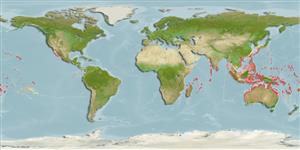Environment: milieu / climate zone / depth range / distribution range
Ecology
Marine; reef-associated; depth range 1 - 15 m (Ref. 27020). Tropical
Indo-Pacific and Western Central Pacific.
Size / Weight / Age
Maturity: Lm ? range ? - ? cm
Max length : 9.9 cm SL male/unsexed; (Ref. 27020)
Dorsal spines (total): 7; Dorsal soft rays (total): 23 - 25; Anal spines: 3; Anal soft rays: 19 - 21; Vertebrae: 10 - 18. Adults' body light brown with scattered vertically elongate dark brown spots. Large pores in interorbital space absent (except in small juveniles). Preopercular spine projecting upward. Caudal vertebrae rarely up to 19. Lateral line scales: anterior 32-38; posterior 14-28 (usually 19-21) when fully developed. Longitudinal line series 53-59.
A shallow-water species (Ref. 27020). Found among corals of wave-washed seaward reefs (Ref. 1602). Benthic species (Ref. 7300, 58302). Solitary and cryptic (Ref 90102).
Life cycle and mating behavior
Maturity | Reproduction | Spawning | Eggs | Fecundity | Larvae
Randall, J.E. and C.C. Baldwin, 1997. Revision of the serranid fishes of the subtribe Pseudogrammina, with descriptions of five new species. Indo-Pac. Fish. (26):56 p. (Ref. 27020)
IUCN Red List Status (Ref. 130435: Version 2024-1)
Threat to humans
Harmless
Human uses
Fisheries: of no interest
Tools
Special reports
Download XML
Internet sources
Estimates based on models
Preferred temperature (Ref.
123201): 24.5 - 29.3, mean 28.1 °C (based on 2338 cells).
Phylogenetic diversity index (Ref.
82804): PD
50 = 1.0000 [Uniqueness, from 0.5 = low to 2.0 = high].
Bayesian length-weight: a=0.01148 (0.00443 - 0.02975), b=3.06 (2.84 - 3.28), in cm total length, based on LWR estimates for this (Sub)family-body shape (Ref.
93245).
Trophic level (Ref.
69278): 3.7 ±0.6 se; based on size and trophs of closest relatives
Fishing Vulnerability (Ref.
59153): Low vulnerability (10 of 100).
Nutrients (Ref.
124155): Calcium = 110 [58, 223] mg/100g; Iron = 0.773 [0.388, 1.395] mg/100g; Protein = 18.4 [16.6, 20.2] %; Omega3 = 0.171 [0.101, 0.292] g/100g; Selenium = 19.5 [9.6, 39.0] μg/100g; VitaminA = 182 [56, 623] μg/100g; Zinc = 1.7 [1.1, 2.5] mg/100g (wet weight);
